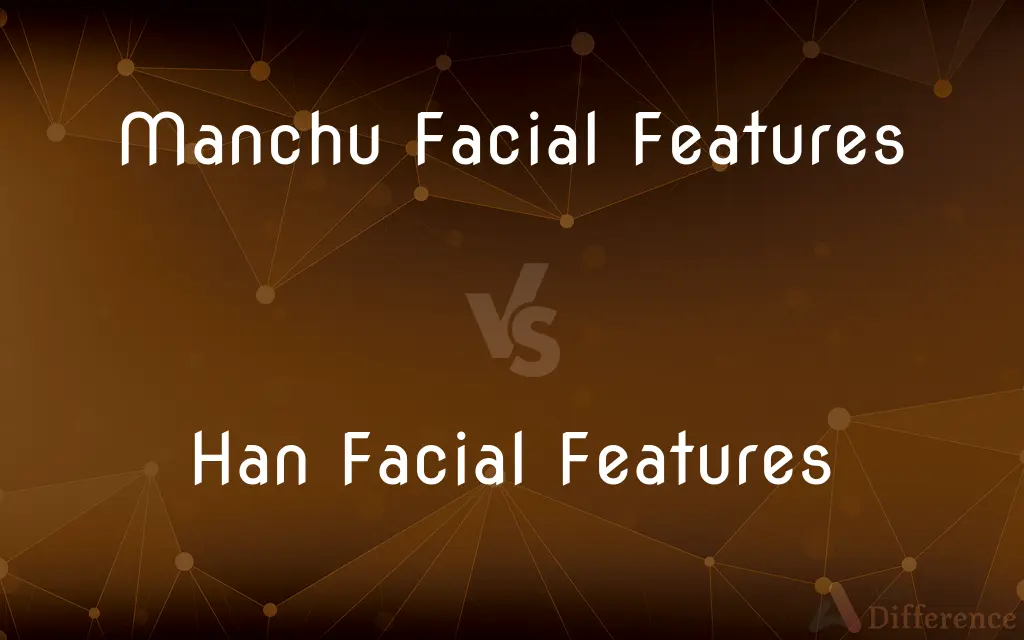Manchu Facial Features vs. Han Facial Features — What's the Difference?
Edited by Tayyaba Rehman — By Fiza Rafique — Published on December 22, 2023
Manchu facial features pertain to the distinct characteristics of the Manchu ethnic group, while Han facial features refer to the typical traits of the majority Han Chinese. Both indicate the unique facial distinctions of their respective groups.

Difference Between Manchu Facial Features and Han Facial Features
Table of Contents
ADVERTISEMENT
Key Differences
The Manchus are an ethnic minority in China, with their own unique history, culture, and physical characteristics distinct from the Han, the majority ethnic group in China. Manchu facial features thus denote those attributes typical to the Manchu people, whereas Han facial features pertain to the majority Han population.
The Manchus originate from Northeast China (Manchuria). Their facial features, over time, may have been influenced by their environment and interactions with neighboring groups. In contrast, the Han Chinese, with a vast population, have more diverse origins and consequently, a wider range of facial features.
Over centuries, the Manchus and the Han have interacted, leading to intermarriage and cultural exchanges. While this has caused some overlap in Manchu and Han facial features, unique distinctions still persist.
In historical art and literature, Manchu facial features might be depicted distinctly to differentiate them from the Han. Han facial features, being more predominant, have set the standard for what is commonly deemed "Chinese" in appearance.
In contemporary times, globalization and increased mobility have led to greater mixing among various ethnic groups, including between Manchu and Han. This might blur the lines between distinct Manchu facial features and Han facial features to some extent.
ADVERTISEMENT
Comparison Chart
Ethnic Origin
Pertaining to Manchu ethnic minority
Refers to the majority Han Chinese
Geographical Roots
Northeast China (Manchuria)
Spread across all of China
Historical Interactions
Influenced by interactions with neighbors in Manchuria
Diverse due to widespread geography
Representation in Art
Distinctly depicted in certain historical contexts
More commonly represented due to majority population
Modern Variation
May be less distinct due to intermarriage and globalization
Still predominant, but also affected by globalization
Compare with Definitions
Manchu Facial Features
Markers of Manchu lineage and heritage.
Despite generations living in southern China, their Manchu facial features remained prominent.
Han Facial Features
Traits commonly seen across different regions of China.
Her Han facial features were a testament to her central Chinese roots.
Manchu Facial Features
Traits seen in people of Manchurian origin.
He recognized her Manchu facial features instantly.
Han Facial Features
A reflection of China's predominant ethnic group.
The sculpture, with its clear Han facial features, stood in the museum's central hall.
Manchu Facial Features
Physical attributes differentiating Manchus from other ethnic groups.
Though he grew up in Beijing, his Manchu facial features distinguished him.
Han Facial Features
Physical attributes representing the Han ethnicity.
Foreigners often found it challenging to distinguish between specific Han facial features.
Manchu Facial Features
Distinct characteristics of the Manchu ethnic group.
Her Manchu facial features were evident from her high cheekbones.
Han Facial Features
Indicators of Han Chinese ancestry and lineage.
Though he had a mixed heritage, his Han facial features were dominant.
Manchu Facial Features
A reflection of Northeast China's indigenous populace.
Artists often highlighted Manchu facial features in their portraits.
Han Facial Features
Characteristics typical to the majority Han Chinese population.
His Han facial features were reminiscent of traditional Chinese paintings.
Common Curiosities
Where do the Manchus primarily originate from?
The Manchus primarily come from Northeast China, particularly Manchuria.
What are Manchu Facial Features?
These are the distinct physical characteristics typical to the Manchu ethnic group.
Are Han Facial Features consistent throughout China?
While predominant, they can vary due to China's vast geography and regional differences.
Has intermarriage affected the distinctiveness of Manchu Facial Features?
Yes, intermarriage and cultural exchange over centuries have led to some overlap in features.
How have modern factors like globalization affected Manchu Facial Features?
Globalization and increased mobility might blur distinct features over time.
Why might there be misconceptions about Manchu and Han Facial Features?
Lack of awareness and generalizations can lead to misconceptions.
How do Han Facial Features differ from other ethnicities?
Han facial features pertain to the majority Han Chinese and might differ from other ethnic minorities in China.
Can someone have a mix of Manchu and Han Facial Features?
Yes, especially if there's mixed ancestry.
What's the significance of art in representing Manchu and Han Facial Features?
Art often captures ethnic distinctions and can provide insights into historical perceptions.
Is there a standard set of characteristics defining Han Facial Features?
While there are common traits, individual variation exists due to genetic and regional factors.
How do genetics play into Manchu and Han Facial Features?
Genetics heavily influence facial features, passed down through generations.
Why might Han Facial Features be more recognized globally?
Being the majority ethnic group in China, Han features are more commonly represented.
Do all people in Northeast China have Manchu Facial Features?
Not necessarily. While Manchus originate from there, the region has diverse inhabitants.
Are there other ethnic groups in China with distinct features?
Yes, China has 56 recognized ethnic groups, each with potential distinctive features.
How have Manchu and Han Facial Features evolved historically?
Both have evolved due to environmental factors, interactions with other groups, and societal changes.
Share Your Discovery

Previous Comparison
Quick Sort vs. Bubble Sort
Next Comparison
Preschool vs. Primary SchoolAuthor Spotlight
Written by
Fiza RafiqueFiza Rafique is a skilled content writer at AskDifference.com, where she meticulously refines and enhances written pieces. Drawing from her vast editorial expertise, Fiza ensures clarity, accuracy, and precision in every article. Passionate about language, she continually seeks to elevate the quality of content for readers worldwide.
Edited by
Tayyaba RehmanTayyaba Rehman is a distinguished writer, currently serving as a primary contributor to askdifference.com. As a researcher in semantics and etymology, Tayyaba's passion for the complexity of languages and their distinctions has found a perfect home on the platform. Tayyaba delves into the intricacies of language, distinguishing between commonly confused words and phrases, thereby providing clarity for readers worldwide.
















































